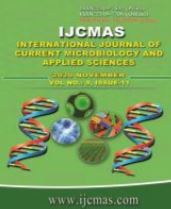


 National Academy of Agricultural Sciences (NAAS)
National Academy of Agricultural Sciences (NAAS)

|
PRINT ISSN : 2319-7692
Online ISSN : 2319-7706 Issues : 12 per year Publisher : Excellent Publishers Email : editorijcmas@gmail.com / submit@ijcmas.com Editor-in-chief: Dr.M.Prakash Index Copernicus ICV 2018: 95.39 NAAS RATING 2020: 5.38 |
A field experiment was conducted during Kharif season of 2008-2009 on typic haplustert at the research farm of Department of soil science and Agricultural Chemistry, College of Agriculture, Latur. The recommended variety MAUS-71 of soybean was used for this experiment. The experiment was conducted in RBD comprising three replications and nine treatments viz. T1(100%RDF), T2(100%RDF+10 t FYM ha-1), T3(50%RDF + 10 t FYM ha-1 +Biofertilizer), T4(100% RDF + 10 t FYM ha-1 +Biofertilizer), T5(100%RDF + 45Kg ha-1), T6(50%RDF + 10t FYM ha-1 + 45kg S ha-1), T7(100%RDF + 45kg S ha-1 + Biofertilizer), T8(50% RDF+10 t FYM ha-1 + 45kg S ha-1 + Biofertilizer), T9(100%RDF + 10 t FYM ha-1 +45kg S ha-1 + Biofertilizer). Chemical properties viz. soil pH, EC and CaCo3 content in soil were not affected due to different treatments but organic carbon content in the soil was affected due to combined application of chemical fertilizers along with enough bulk of farm yard manure containing treatments. Highest organic carbon (1.38%) was recorded due to use of 100% RDF +10 t FYM ha-1 + 45 kg S ha-1 + Biofertilizer (T9) treatment followed by 50% RDF +10 t FYM ha-1 + 45 kg S ha-1 + Biofertilizer (T8). Organic carbon content in soil samples collected after harvest of the crop was increased in all the treatments over initial (0.31%) soil sample due to residual effect of soybean crop grown under INM treatment.
 |
 |
 |
 |
 |